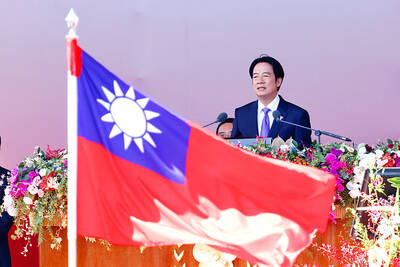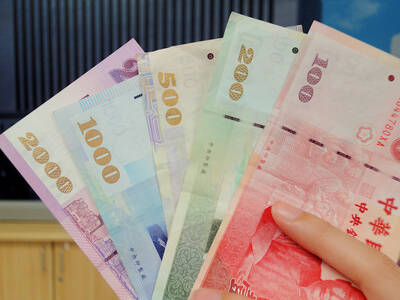Last-gasp negotiations to save Italy’s flag carrier Alitalia resulted in a draft deal signed yesterday by four out of nine unions, but the move sparked attacks from pilots and cabin crews.
Delegates of the four national union confederations representing Alitalia staff signed the deal with CAI, a consortium prepared to invest in a new revamped Italian airline, it was announced early yesterday.
While the move allows Italian Prime Minister Silvio Berlusconi to save face after his promise to produce an Italian rescue package, it does not yet remove the possibility of bankruptcy.

PHOTO: AFP
However, the agreement did not include new contracts, one of the sticking points in the negotiations, and was immediately denounced by the five unions that did not take part: SDL, ANPAC, UP, ANPAV and Avia.
“Any document that is produced without the direct participation of unions that represent all workers is considered useless and a provocation,” the five unions said in a statement.
But Italian Employment Minister Maurizio Sacconi said it was “a solid base upon which to build a future for [our] national carrier.”
Raffaele Bonanni, the leader of the CISL labor confederation that backed the plan, also defended the agreement.
“We’ve done a good job,” he said in an interview published yesterday in Corriere della Sera.
“At the end the layoffs will total 3,200,” he said.
The figure was in line with what Sacconi had suggested earlier this month, and lower than the 5,000 to 7,000 layoffs that had previously been expected.
Bonanni said the agreement over the industrial plan is the “basis for everything else.”
Under the accord, the number of personnel employed by the new Alitalia will be 12,500 including 1,500 pilots, 3,300 cabin staff and 7,650 technicians, workers and managerial staff, ANSA news agency said.
CAI had previously offered to employ only 11,500 people, ANSA quoted the unions as saying.
The fate of around 1,000 call-center staff in particular remained unclear.
Last-ditch talks to save Alitalia had got under way on Sunday, with prospective buyers, unions and the government struggling to agree on how to salvage the country’s flag carrier.
The meeting wound up early yesterday with approval of the draft deal laying out the industrial plan of the new company but avoiding the thorny problem of a single contract for all staff proposed by CAI.
That was to be addressed at a fresh meeting with unions later yesterday.
Under the latest rescue plan, the Italian consortium, which has put a 1 billion euro (US$1.4 billion) offer for the airline on the table, would ensure passenger flights keep running.
Alitalia would also merge with Air One, Italy’s second-largest airline, and its 1.2 billion euro debt would be absorbed by a second company, which would then be liquidated.
Earlier meetings this weekend yielded small advances, according to daily La Repubblica, which reported that potential buyers increased their salary package for Alitalia employees by 100 million euros.
Berlusconi, who has personally intervened in the talks, said on Saturday that Alitalia’s closure would be a “disaster for the entire country.”
The company has been living on state-funded life support, with Italian investors and unions having failed to agree on the salary, vacation and contract demands outlined in the current takeover package.
Massimo Notaro, the head of one of Italy’s two main pilot unions, UP, said on Sunday that a CAI forecast that 1,000 pilots might lose their jobs was “completely unacceptable.”
A proposed takeover of Alitalia by Air France-KLM fell apart in April when the French-based carrier walked away from talks after unions rejected terms.
The Italian government owns 49.9 percent of Alitalia.

People can preregister to receive their NT$10,000 (US$325) cash distributed from the central government on Nov. 5 after President William Lai (賴清德) yesterday signed the Special Budget for Strengthening Economic, Social and National Security Resilience, the Executive Yuan told a news conference last night. The special budget, passed by the Legislative Yuan on Friday last week with a cash handout budget of NT$236 billion, was officially submitted to the Executive Yuan and the Presidential Office yesterday afternoon. People can register through the official Web site at https://10000.gov.tw to have the funds deposited into their bank accounts, withdraw the funds at automated teller

PEACE AND STABILITY: Maintaining the cross-strait ‘status quo’ has long been the government’s position, the Ministry of Foreign Affairs said Taiwan is committed to maintaining the cross-strait “status quo” and seeks no escalation of tensions, the Ministry of Foreign Affairs (MOFA) said yesterday, rebutting a Time magazine opinion piece that described President William Lai (賴清德) as a “reckless leader.” The article, titled “The US Must Beware of Taiwan’s Reckless Leader,” was written by Lyle Goldstein, director of the Asia Program at the Washington-based Defense Priorities think tank. Goldstein wrote that Taiwan is “the world’s most dangerous flashpoint” amid ongoing conflicts in the Middle East and Russia’s invasion of Ukraine. He said that the situation in the Taiwan Strait has become less stable

REASSURANCE: The US said Taiwan’s interests would not be harmed during the talk and that it remains steadfast in its support for the nation, the foreign minister said US President Donald Trump on Friday said he would bring up Taiwan with Chinese President Xi Jinping (習近平) during a meeting on the sidelines of the APEC Summit in South Korea this week. “I will be talking about Taiwan [with Xi],” Trump told reporters before he departed for his trip to Asia, adding that he had “a lot of respect for Taiwan.” “We have a lot to talk about with President Xi, and he has a lot to talk about with us. I think we’ll have a good meeting,” Trump said. Taiwan has long been a contentious issue between the US and China.

FRESH LOOK: A committee would gather expert and public input on the themes and visual motifs that would appear on the notes, the central bank governor said The central bank has launched a comprehensive redesign of New Taiwan dollar banknotes to enhance anti-counterfeiting measures, improve accessibility and align the bills with global sustainability standards, Governor Yang Chin-long (楊金龍) told a meeting of the legislature’s Finance Committee yesterday. The overhaul would affect all five denominations — NT$100, NT$200, NT$500, NT$1,000 and NT$2,000 notes — but not coins, Yang said. It would be the first major update to the banknotes in 24 years, as the current series, introduced in 2001, has remained in circulation amid rapid advances in printing technology and security standards. “Updating the notes is essential to safeguard the integrity